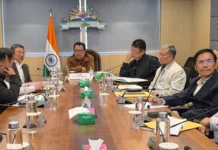[ Hage Mobbing ]
China has been actively constructing dams on the Yarlung Tsangpo river, with plans for the world’s largest hydropower project in Tibet. This mega-dam is expected to have a capacity of 60,000 MW, three times that of the Three Gorges Dam.
Additionally, China has already built two major dams on the river, strategically placed near the Yarlung Tsangpo Grand Canyon. These projects have raised concerns about their environmental impact and potential geopolitical implications for India. China has approved the construction of the world’s largest hydropower project on the Yarlung Tsangpo river in Tibet, with a capacity of 60,000 MW, three times that of the Three Gorges Dam. The river flows into Arunachal Pradesh as the Siang, into Assam as the Brahmaputra, and then into Bangladesh before reaching the Bay of Bengal.
The project is expected to have a significant impact on the livelihoods, ecology, and water availability for millions downstream. India has consistently expressed concerns to China about such projects, emphasizing the need for transparency and consultation to protect downstream states’ interests.
The Yarlung Tsangpo hydropower project is set to be the world’s largest hydropower project, planned at the Great Bend of the river in Medog county, Tibet, where it makes a U-turn before entering Arunachal.
The project is part of China’s 14th Five-Year Plan (2021-2025).
According to experts, the project’s location has been strategically chosen. Recent activities, including funding allocation, construction of smaller dams, and changes in upstream land use, suggest that the project is in an advanced planning phase, with visible construction expected soon.
China aims to use the Yarlung Tsangpo project to reduce reliance on conventional energy sources and achieve net carbon neutrality by 2060.
The river’s steep descent from the mountains provides an ideal flow rate for hydroelectricity generation, making it a prime location for such a mega project.
China’s recent dams, including the Three Gorges Dam, highlight the massive scale of its hydropower ambitions. However, these projects have raised significant environmental concerns.
The Three Gorges Dam, for instance, has altered gravity anomaly maps due to the immense weight of stored water, caused severe ecological impacts, and even triggered earthquakes.
Additionally, over a million people were displaced due to changes in river morphology. The Yarlung Tsangpo project could replicate these environmental and social risks on a larger scale, posing significant challenges for downstream regions.
The proposed dam could significantly affect water flow from China to India, a lower riparian state, as most of the water in the Brahmaputra system originates in Tibet. Any alteration in water flow could disrupt agriculture and water availability in India.
Large dams often block the flow of silt, essential for agriculture, and cause changes in river flow, adversely affecting local biodiversity. These disruptions could have long-term ecological and agricultural consequences for the region.
The region is one of the most ecologically fragile and earthquake-prone areas in the world. A large dam in this zone increases the risk of catastrophic events.
For instance, the 2004 Parechu Lake landslide in Tibet, which later burst in 2005, highlights the dangers of water accumulation in unstable regions, despite timely coordination to mitigate damage.
Effective coordination and real-time exchange of information between countries are crucial to prevent disasters. However, China has shown reluctance to cooperate with lower riparian states like India.
Similar concerns have been observed in the Mekong river basin, where China’s 12 large dams have negatively impacted downstream nations.
India and China have several agreements for cooperation on transboundary rivers:
Umbrella MoU (2013): Covers overall cooperation on transboundary rivers and has no expiry date. However, no activity is currently being undertaken under this agreement.
Brahmaputra MoU: Signed for data sharing and renewable every five years. It lapsed in 2023, and its renewal is under process via diplomatic channels.
Sutlej MoU: Initiated after the 2004 Parechu Lake incident but does not provide year-round data. This MoU is also pending renewal.
Expert Level Mechanism (2006): This mechanism facilitates annual meetings between India and China to discuss transboundary river issues.
However, interruptions have occurred in recent years. China has been reluctant to share data consistently, with interruptions noted during the 2017 Doklam crisis and the 2020 Ladakh standoff.
While neither India nor China is a signatory to the 1997 UN Convention on the Law of the Non-Navigational Uses of International Watercourses, both countries abide by its key principles.
These include equitable and reasonable water use and ensuring that actions of one country do not significantly harm another.
Given the limited avenues of coordination and the potential risks posed by mega projects like the Yarlung Tsangpo dam, robust mechanisms and renewed agreements are critical for preventing disputes and ensuring regional stability.
India and China have a narrow and limited understanding when it comes to transboundary river issues. China has been unwilling to agree to any commitments that could address India’s concerns comprehensively.
Construction of dam with capacity to accumulate the sudden opening of all the dam gates in the dams in China and to store reasonable quantity of water in the Indian dam to regulate the river flow during the lean period and unannounced closure of the dam gates to choke the river flow.
China often claims its hydropower projects are run-of-the-river, implying minimal water impounding and limited downstream impact. However, India views these assertions sceptically.
India must challenge China’s statements, including the recent claim that the Tsangpo mega dam would have no downstream impacts. Without publicly countering such narratives, these projects could become fait accompli, creating long-term challenges for India.
India should push for an honest dialogue with China and attempt to dissuade them from pursuing large-scale projects like the Tsangpo mega dam. Water-related concerns should become a significant focus in India’s engagement with China. India needs to clearly convey that disregarding its interests and concerns will negatively impact bilateral relations.
The Yarlung Tsangpo dam could disrupt water flow from Tibet, affecting agriculture and water availability in India, especially in Assam and Arunachal. It may also interrupt silt flow, harming agriculture, and pose ecological risks due to the fragile and earthquake-prone region. The projects in the Yarlung Sangpho could be used as potential water booms to unlash flood in the Siang belt of Arunachal, and in Assam and Bangladesh.
India and China have agreements such as the Umbrella MoU and the Brahmaputra MoU, focusing on data sharing and cooperation. However, there have been challenges in consistent cooperation, with data-sharing disruptions during tensions like the 2017 Doklam and 2020 Ladakh standoff. There is no treaty between the India and China unlike the IWT (Indus water Treaty) between Pakistan and Indiak, which is under suspension after Operation Sindoor.
Even the MoU between China and India is after continuous persuasions from India after the notorious Siang floods in 1998 and 2000 which had caused unbelievable devastations in the Siang belt areas like Pasighat and adjoining areas like Mebo, Ruksin and Jonai, besides innumerable infrastructure damages along the Siang river’s courses in the upper ridges. This could have been moderated and regulated if there was a dam in between with few billion cubic metres’ storage capacity.
After the 2000 flood in Pasighat (Siang river flood), a few like-minded people and officers organized a charity show to be donated to the flood-affected people and we, the Pasighat team of the charity show organizers, made the highest contribution for the cause.
India has long had its own designs on damming the Brahmaputra. Now its desire for hydroelectricity has been combined with the urge to protect the country from the perceived risks posed by China’s project. After China’s Christmas Eve announcement, India’s water ministry revived a 2017 plan for an 11,000-megawatt dam on the river in Arunachal, just downstream of the canyon. Known as the Siang Upper Multipurpose Project (SUMP), it would be India’s largest hydroelectric dam. The SUMP is not just about generating power, but also about maintaining the natural flow of the river and mitigating potential flood risks from water releases by China
The project is wholly owned and developed by Power Construction Corporation of China (PowerChina), a state-owned construction enterprise. Commercial operations were planned to begin in 2033. With a projected investment of more than quadruple that of the Three Gorges Dam (which cost 250 billion yuan), the Medog hydropower station represents one of China’s most ambitious infrastructure projects and one of the most expensive infrastructure projects in history. The facility’s planned annual power output of 300 billion kilowatt-hours would establish it as the world’s most productive hydroelectric installation, significantly surpassing current records.
The project intends to harness a 2,000 metre river elevation drop within a 50-kilometre stretch, granting it the ability to generate significant amounts of hydroelectric power. This section flows through the Yarlung Tsangpo Grand Canyon, recognized as Earth’s deepest canyon system. The intended construction plan necessitates the excavation of four 20-kilometre tunnels through the Namcha Barwa mountain to divert the Yarlung Tsangpo river.
Hydropower projects can be built in many places and many rivers in the Arunachal, leaving the SUMP over the Siang river and also run-of-the river projects can come up in the Siang river, rather that storage dam projects if power requirements and potentials are to be harvested; but we need storage dams to store the sudden dam gate openings as hydrological data are not shared by China despite MoU and there is no water treaty between India and China. This the only way to block Chinese water boom floods in the future. As China does not have enough infrastructures now to choke the Siang and the Bharamaputra rivers, it can definitely flood it during monsoon, and prevention is better than cure.
My firsthand experience and knowledge concludes that a pre-feasibility report can be undertaken to check if construction of dam is possible, then a feasibility survey, environmental assessment and design with highest possible earthquake resistance based on the seismic zone. However, I leave it to the wisdom of the people who are likely to be affected by dam construction and who are at the helms of affairs to enlighten what we need for our peoples’ security and the country’s security – whether to construct SUMP dam or not. (The contributor is an engineer who has spent about 18 years of his service life in the Siang belt and experienced the great floods in the Siang river in 1998, 2000 and 2004 as water resources officer in Pasighat. He can be reached at hmobbing69@gmail.com)



